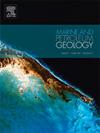碳酸盐胶结物热记录:解读东营坳陷北部始新统沙河街组砂岩热液印记
IF 3.6
2区 地球科学
Q1 GEOSCIENCES, MULTIDISCIPLINARY
引用次数: 0
摘要
东营凹陷始新统沙河街组砂岩中的碳酸盐胶结物记录了与热液活动有关的重要时间和热信息。本研究对这些碳酸盐胶结物进行了全面的研究,详细介绍了它们的成岩过程、年代形成和物质来源。沉积学研究表明,研究区砂岩以三角洲和边缘湖沉积为主,在微观尺度上可分为富基质型和贫基质型。岩石学观察和电子探针显微分析(EPMA)表明,方解石是主要的自生矿物相,其丰度和形态随砂岩成熟度的变化而变化。贫基质砂岩,成熟度较高,以块状方解石胶结为主,而富基质砂岩,成熟度较低,则倾向于发育散斑状方解石。流体包裹体均质温度表明,这些方解石胶结物是在异常高温条件下析出的,温度范围为85 ~ 350℃。碳酸盐胶结物δ13C(- 11.8 ~ - 3.1‰VPDB)和δ18O(紧密聚集在- 14.0 ~ - 11.1‰VPDB)值较低,反映了岩浆CO2、空气CO2和土壤CO2的混合来源。方解石的原位U-Pb同位素定年限制了碳酸盐胶结沉淀的时间,年龄范围为39.4±1.9 Ma至42±7.6 Ma。研究结果表明,本区始新统沙河街组砂岩碳酸盐胶结物的钙源主要是原生碱性地层水与热液流体的混合。碳源以岩浆CO2和空气CO2的混合为主,土壤CO2可能有少量贡献。研究认为,影响研究区碳酸盐岩胶结作用的热液活动可能与新生代新太平洋板块的俯冲有关。通过多种先进分析技术的整合,阐明了热液衍生碳酸盐胶结物的物质来源和沉淀时间,验证了方解石U-Pb原位同位素定年等先进技术在碎屑岩研究中的潜在应用。此外,本研究确定的沙河街组热液活动年龄为研究东营凹陷构造岩浆活动提供了重要的数据支持。本文章由计算机程序翻译,如有差异,请以英文原文为准。
Thermal records of carbonate cements: Deciphering the hydrothermal imprint on Eocene Shahejie Formation sandstones in the northern Dongying Depression, China
The carbonate cements in the sandstones of the Eocene Shahejie Formation in the Dongying Depression record crucial temporal and thermal information related to hydrothermal activity. This study presents a comprehensive investigation of these carbonate cements, detailing their diagenetic process, chronological formation, and material origins. Sedimentological evidence indicates that the sandstones in the study area were predominantly deposited in deltaic and marginal lacustrine settings, with a subdivision into matrix-rich and matrix-poor types at the microscale. Petrographic observation and electron probe microanalysis (EPMA) reveal that calcite is the predominant authigenic mineral phase, exhibiting variability in both abundance and morphology depending on sandstones maturity. Matrix-poor sandstones, characterized by higher maturity, predominantly exhibit blocky calcite cement, whereas those with a rich matrix and lower maturity tend to develop scattered patchy calcite. Fluid inclusion homogenization temperatures indicate that these calcite cements precipitated under abnormally high-temperature conditions, ranging from 85 to 350 °C. And the carbonate cements exhibit low δ13C (−11.8 to −3.1 ‰ VPDB) and δ18O (clustered tightly from −14.0 to −11.1 ‰ VPDB) values, interpreted to reflect a mixed source comprising magmatic CO2, air CO2, and a potential contribution from soil CO2. In situ U-Pb isotopic dating of calcite constrains the timing of carbonate cement precipitation, with ages ranging from 39.4 ± 1.9 Ma to 42 ± 7.6 Ma. Ultimately, the results indicate that the calcium source for the carbonate cements in the Eocene Shahejie Formation sandstones of this region is primarily a mixture of primary alkaline formation waters and hydrothermal fluids. The carbon source is dominated by a mixture of magmatic CO2 and air CO2, with a potential minor contribution from soil CO2. This study suggests that the hydrothermal activity influencing carbonate cementation in the study area was likely associated with the Cenozoic subduction of the New Pacific Plate. Through the integration of multiple advanced analytical techniques, this study elucidates the material origins and precipitation timing of hydrothermal derived carbonate cements, validating the potential application of advanced techniques such as in situ U-Pb isotopic dating of calcite in clastic rock research. Additionally, the hydrothermal activity age determined for the Shahejie Formation in this study provides crucial data support for the research on tectonic-magmatic activity in the Dongying Depression.
求助全文
通过发布文献求助,成功后即可免费获取论文全文。
去求助
来源期刊

Marine and Petroleum Geology
地学-地球科学综合
CiteScore
8.80
自引率
14.30%
发文量
475
审稿时长
63 days
期刊介绍:
Marine and Petroleum Geology is the pre-eminent international forum for the exchange of multidisciplinary concepts, interpretations and techniques for all concerned with marine and petroleum geology in industry, government and academia. Rapid bimonthly publication allows early communications of papers or short communications to the geoscience community.
Marine and Petroleum Geology is essential reading for geologists, geophysicists and explorationists in industry, government and academia working in the following areas: marine geology; basin analysis and evaluation; organic geochemistry; reserve/resource estimation; seismic stratigraphy; thermal models of basic evolution; sedimentary geology; continental margins; geophysical interpretation; structural geology/tectonics; formation evaluation techniques; well logging.
 求助内容:
求助内容: 应助结果提醒方式:
应助结果提醒方式:


